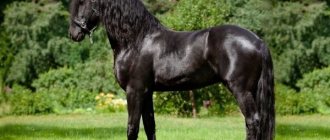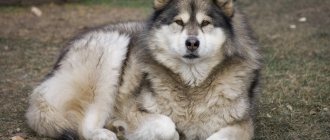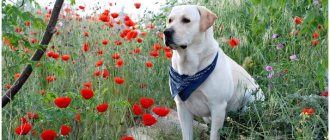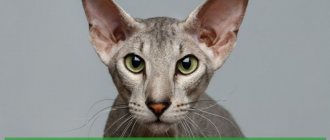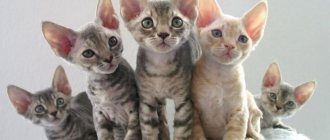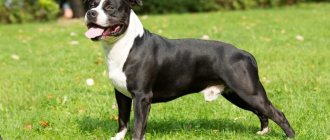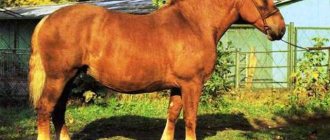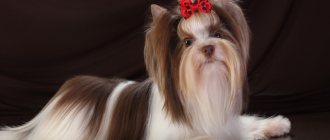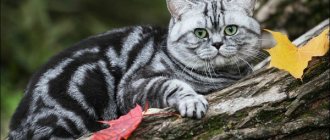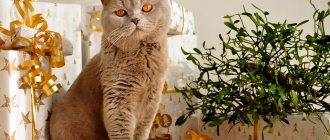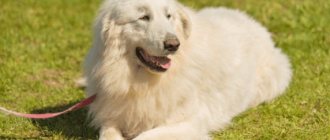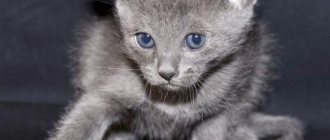12.04.2013
Breeds of horses and ponies
The height of a Friesian horse is above 150 cm.
The suit is only black. Mares have a small mark - an asterisk. Stallions have no markings.
Exterior - the Friesian horse is very elegant, tall, long-legged. And although the Friesian horse is quite massive and large, it still looks royal.
The horse's warehouse is harness. The long back is often soft. Slightly stretched but wide body. Large, elongated head with long ears, beautifully curved neck. The most important distinguishing feature of the Friesian breed is the thick, shaggy brushes that flow down to the hooves; this is called “friesianness.”
Despite all their grace and elegance, Friesian horses are heavy-duty horses.
Maintenance and care
As already mentioned, being very unpretentious to their living conditions, Friesians are somewhat picky about the composition of their food. We will consider the features of animal care below.
Stable
In order for animals to feel comfortable, the stable for them should be:
- with spacious stalls equipped with lattice partitions and the same door;
- well ventilated;
- illuminated by bright light;
- devoid of any drafts;
- equipped with feeders, mangers and drinking bowls, fixed at the level of the horse’s chest;
- insulated, with year-round temperature in stalls in the range from 16 to 18 ° C;
- with a wooden, adobe or stone floor covered with a bedding of straw, sawdust, peat or substandard hay, the height of which should be such that a pitchfork stuck into it does not reach the floor.
Did you know? The high rise of the legs during a trot, characteristic of the Friesian breed, has a special name - carriage, since it looks very impressive in Friesians harnessed to a carriage.
Care
This breed requires very careful care of both the horses themselves and their stalls. Manure and contaminated parts of the litter must be removed daily, changing the litter completely weekly. You should also thoroughly wash the feeder and drinker once a week.
As for the animal itself, caring for it consists of the following:
The bushy tail, mane and friezes on the horse’s legs require special attention. They need to be brushed daily, using sprays and shampoos if necessary. Three times a week it is useful to treat the mane and tail with special conditioners, which make combing much easier. The short hair on the body of horses should be combed in the direction of hair growth using special brushes and combs, after which it is useful to wipe it with suede to give it shine. Periodically you need to bathe your horse - either by watering it with a hose, or by letting it into an open body of water. Every month or once every month and a half, it is necessary to clean the hooves of dirt and small stones clogged with special brushes and hooks with blunt tips. After this procedure, it is useful to treat the hooves with a nourishing ointment that prevents creases.
Keeping horseshoes in good condition is of no small importance for hooves, for which it is necessary to promptly replace worn or damaged ones.
Important! Friesian horses are known to have a sweet tooth, so they can be treated or encouraged by giving them a piece or two of sugar.
Feeding
Friesian horses are demanding of the food offered to them.
Therefore, their daily feeding ration should consist of:
- 5 kg of whole grain oats;
- 1 kg bran;
- 13 kg of hay;
- 3 kg of raw carrots;
- 1.5 kg crushed barley;
- 0.2 kg of mineral supplements;
- 0.03 kg table salt.
The diet varies depending on age, gender and season.
In addition, it should be added:
- potato;
- beets;
- corn;
- wheat;
- silage.
Feeding usually begins with roughage in the form of hay, followed by succulent feed, and ends with grain crops. In winter, horses are fed three times a day, and in warm periods - in the mornings and evenings.
And, of course, animals must have constant and free access to fresh water. Automatic drinking bowls connected to a water supply are best suited for this. If they are not there, it is necessary to change the water in the drinking bowls daily, first emptying them of old water and rinsing them.
Important! A table salt lick must be present in the feeder.
Having experienced ups and downs throughout its long history - from high demand to almost extinction, Friesian horses now delight connoisseurs with their original appearance and easy-going disposition, remaining outstanding representatives of a diverse horse breed.
Configuration
Measurements: Height at withers from 150 cm to 162.
Gait
Color: Exclusively black. The only markings allowed are an asterisk with a diameter of no more than 30 mm on mares. Markings are not allowed on stallions.
: Frieze is a horse that is not very large, bony, but elegant, somewhat high-legged, with a pronounced draft style. Frisians have a rough, loose constitution. The body is wide and deep, but slightly stretched, the back is long and often soft. The looseness of the constitution is hidden by the high neck and elongated shape. The frieze's neck has a beautiful slight curve, set very high, and the head is large, long, with an almost straight profile and long, strict ears. The most memorable feature of the Friesian horse is the very long and thick brushes that cover the bony powerful legs from the hock and carpal joints and flow down to the large black hooves (the so-called friezes).
These are hairy horses, meaning they have friezes hanging down their legs. The breed cultivates the so-called “carriage gait” - when the horse’s legs at a trot move in a large circular amplitude with a loss of speed on smooth ground, but with the least physical effort on deep, soft ground (snow, sand). Owners often seek to improve their horses' natural movement by using a "Friesian harness" in training, a device of ropes and pulleys that connect a bit to each horse's leg.
Friezes are famous for their ease of learning, human orientation, and ease of use. Most often they have gaits that are soft for the rider. However, professional driving athletes prefer to use more intelligent breeds.
Friesian horses have an energetic temperament, they are quite calm and balanced. They are not disturbed by large crowds of people, they remain unshaken by the sounds of loud music, therefore they are often used at special events and holidays.
Breed Features
Although Holland cannot boast of much variety, two of them occupy the top positions in the world “hit parade”. Friesian breed among them
These large ones, with their incredibly beautiful stance and gait, attract the attention of everyone, everywhere. Having survived difficult times in their history, today the Frisians have found their place in the sun and are the subject of adoration of millions of people
Origin story
The Friesian horse breed began its history in ancient times in a fabulously beautiful area in the north of Holland called Friesland. There is a possibility that the ancestors of the Frisians were wild forest European horses.
They were quite large and hardy, which at one time attracted the attention of the Romans. They began to use them in heavy cavalry
Hippologists are sure that the first attempts to improve the appearance of forest horses by infusing oriental blood (Barbary horses) began then.
Already taller, but no less strong and hardy horses a little later came to the British Isles, where they left an invaluable contribution to the development of many draft breeds (Clydesdales, Shires, etc.). In the Middle Ages, these horses became indispensable for knights and made up most of the crusader cavalry. At the same time, more attempts were made to bring in eastern blood - Arab purebred. This made the ancestors of modern Frisians more playful and active. But the famous Spanish Andalusians gave these horses special elegance and elegance.
In 1568, an image of a horse was dated, which was very close in type to modern friezes. This painting depicts the horse "Friso", which belonged to the Austrian ruler of Naples. Today, a copy of this painting crowns the entrance to the Friesian Breed Center in the city of Drachten. Having received from the Andalusians a certain majesty, a characteristic bend of the neck and a high move, the Friesian gradually turned from a working war horse into a ceremonial dressage and harness horse.
Horse breeding became a very important industry throughout Friesland, and the Friesian breed of horses began to be massively exported to many European countries. Around 1620, the first Frisians appeared in America
Many may be surprised, but it was from the Frisians that trotting horse breeding originated, and it was these black horses that were the first to be tested on racetracks. By the beginning of the 19th century, trotting trials were carried out in many regions of Europe. A little later, special “Friesian carts” were invented, and in 1823, King William I of the Netherlands opened racing in the city of Leeuwarden. These competitions were held for a very long time, until the bulky Friesians were forced out of the hippodrome tracks by lighter American and Russian trotters.
The first breed book, the Friesian studbook, was created in 1879 by Dutch farmers. At the same time, a ban was approved on other breeds due to the preservation of the purity of the breed. Today the breed studbook numbers about 60,000 horses.
Exterior
Friesian horses cannot be confused with any other breed. These are large, massive typical carriage horses with a noble large head and a high neck. They are classified as the so-called “Baroque” type. They have a deep body, low withers, straight shoulder blades, a soft wide back, a long muscular croup and fairly high legs. The height at the withers for stallions is on average 160-165 cm, for mares - from 150 cm.
Speaking about the appearance of these horses, it is impossible not to mention their special elegant gait and the so-called “Friesian trot”. The fact is that when moving, these horses raise their heads high, bend their necks in an arc, extend their bodies and raise their legs very high. Thanks to this, they get a very elegant parade trot that maintains good agility. We offer you to verify this in the video (author Yana Khromova).
Character
Friesian horses are distinguished by their nature, like many draft breeds, by their calm and good-natured character. Therefore, they can easily be used as a hobby horse. With proper upbringing and training, despite their size, they easily obey the reins, are contactable and flexible. However, they also have enough ardor and temperament. Also, those who have experienced riding Friesians say that these horses can be somewhat stubborn.
Characteristics and description of the breed
Friesian horses are distinguished by their extraordinary elegance and grace, and also have an easily recognizable appearance. Over the course of several centuries, this breed has managed to preserve the full range of its universal qualities.
Height and weight
The Friesian horse is a stately animal. The height of the individual reaches 160-165 cm. In addition, horses of this breed belong to the category of heavy animals and have a powerful physique. The mass of the individual is 600-680 kg.
Exterior
The Friesian stallion has a bright and expressive exterior, making it easily recognizable.
This type is characterized by the following parameters:
- The head is large, elongated, with very expressive dark eyes. The profile is straight with short and neat ears. The nostrils are quite wide.
- The neck is long and muscular, with a graceful curve. The species is characterized by long and developed withers.
- The back is quite strong and strong with a somewhat elongated body. The body has powerful, obliquely set shoulders. The chest is moderately wide.
- The animal's legs are long, strong, with durable hooves. The brushes are well defined on the legs. Thanks to their high position, the brushes fall in thick curls all the way to the hooves. This feature was called “freezing” and migrated to other types. The presence of such decoration on the limbs is a basic feature of Friesian horses and gives them a colorful “fairytale” appearance.
- Short and shiny hair covers the animal's thick skin. The Friesian breed is also characterized by an unusually long mane and an equally long, thick and bushy tail.
Suit
Friesian horses are representatives of the black color. Any other colors are completely unusual for them. At the same time, the skin of the Friesian horse is completely devoid of marks, which is clearly visible in the photo.
In past centuries, this breed came in many colors: bay, black, forelock and gray. As a result of the crises, the genetic diversity of the species has decreased significantly. Today, this species is known exclusively in one color - black. Occasionally, mares have a small star-shaped mark. Stallions must not have any white markings.
Did you know? Due to the almost complete absence of any minute markings on the coat of Friesian horses, they are often called “black pearls.” This feature has become a real calling card of the variety.
Character and disposition
The most important character trait of Frisians is their balance. These black giants are famous for their gentle and friendly disposition. Horses are very good-natured towards both adults and children. However, behind the external calm and composure lies an energetic temperament.
This combination allows horses to be used for both amateur walking and professional riding. In addition, representatives of Frisians have excellent memory and high performance, they are inquisitive. All these qualities help to train animals quickly and easily.
Let us also note the relative unpretentiousness of these giants. Friezes can withstand changing weather conditions well. But at the same time, horses are a little more capricious regarding the quality and composition of feed.
Important! Friesian horses are very fond of sweets, so they need to be regularly fed with sugar.
Distinctive features
The Friesian horse stands out among other breeds by its features, brushes and mane, color, character and disposition, and running. We have already discussed some of these features above.
The black color combined with a thick luxurious mane, tail and brushes creates the impression that these noble and beautiful animals came straight from the pages of knightly novels. Horse breeders often prefer not to trim the animal and let the curls grow to the ground. When moving, lush hair flows over the body and creates a beautiful picture.
Since Friesians are heavy animals, they have a fairly loose constitution. However, this disadvantage is compensated by high and slender legs.
In addition to external characteristics, the specific feature of the Friesian horse is its high and sweeping running. These horses move with a precise move characteristic only of them, raising their limbs high.
Many horse breeders classify the Friesian as a weak breed, since such a gait requires a significant expenditure of energy when lifting the legs. But it is precisely thanks to this specificity that running acquires a special charm and looks graceful.
We recommend reading about other horse breeds: Vladimir draft horse, Arabian, Tinker, Appaloosa, Akhal-Teke.
Usage
Previously, Friesians were universal horses: they were indispensable helpers for peasants, as well as an indispensable attribute of ceremonies and noble trips. Today, these black beauties are still an integral part of social life; they staff the royal stables of the Netherlands, Denmark and Luxembourg. In addition, they are widely used in amateur horse riding, dressage and, of course, driving - in horse-drawn carriage competitions.
The Netherlands Equestrian Federation pays special attention to the popularization of the Friesian breed. Every year the country hosts competitions in dressage and national chaise teams.
Also, every year in Drachten there is a festival of Friesian horses, which includes a parade, shows and all kinds of competitions and demonstrations.
Modern cinema cannot do without the participation of friezes. Almost every historical or fantasy film shows us the beauty and majesty of these black beauties. Appearing for the first time on screen in 1985, friezes starred in such famous films as “Alexander”, “300”, “The Mask of Zorro”, “Conan the Barbarian”, “The Chronicles of Narnia” and many others.
Loading …
Application of friezes
Friesians survived as farm horses, especially in the villages of Holland.
Friesians are used as tourist horses, in the circus, dressage, driving and carry ceremonial carriages.
Friesian horses are also used as decorative horses; they are very popular for photo shoots.
Photo sessions with friezes are very popular
Breeding Friesian horses
Any breed needs to preserve and improve its qualities in subsequent generations. Horses undergo a very strict selection process before they are selected for breeding. In addition to impeccable pedigree and spectacular appearance, animals must have excellent working qualities. This is controlled by a check called ke-rung. Horses are also selected according to the standards that candidates for reproduction must meet: compliance with standard measurements, height, weight, character. Usually, after checking 1000 individuals, only a hundred are selected. For example, a stallion, having undergone selective selection, must also have impeccable health and excellent performance.
Each successful foal is registered by the Royal Friesian Stud Book, which has existed since 1879, where you can trace the pedigree of each thoroughbred horse. The right to carry out breeding work belongs to the breed association or its branches after careful selection of animals.
Within a year, a newborn foal is implanted with a chip with an individual number and entered into the stud book. Only such foals are considered purebred Friesians. Spontaneous breeding outside an association is considered illegal, and newborn foals without a chip cannot be entered into the breed’s studbook and are therefore considered outbred.
Friesian horses are rightly called black pearls. There are over 120 of them in Russia, and they are used in equestrian sports. Individual breeders have fallen in love with this ancient, majestic breed and are breeding it.
Friezes in the service of man
The Friesian horse breed was saved due to increased interest and attention in equestrian sports. Such qualities as intelligence, friendliness, majesty, and nobility of appearance, which are inherent in many individuals belonging to the breed, have become in demand. Now Friesians are used very widely. They star in films and perform in the circus arena. These animals are used for horse riding. Their calm disposition will appeal to riders who have only a little experience in equestrian sports. The Friesian horse takes an active part in many equestrian sports, such as driving, dressage and eventing.
Breeding work carried out in the modern world is aimed at enhancing sporting qualities. The first place is given to a good-natured character, an elegant physique and a quick mind. Today, the population of this breed has been completely restored. All Friesian horses must be registered in a stud book, divided into sections. Each of them has its own characteristic color for registration forms. This will allow you to determine the pedigree status of a stallion or mare, even in the absence of knowledge of the language.
Breeding Features
Out of a thousand foals, only one hundred representatives of the breed are selected for breeding.
The breeding and selection of Friesian horses is under the control of the International Friesian Studbook Society. The center of the organization is located in Drathen, in addition to it there are 11 branches located in other countries.
The society evaluates the breed, issues documents, and selects young animals for breeding work.
When selecting horses for breeding work, natural data is taken into account; indicators such as:
- height;
- weight;
- temperament;
- working qualities.
As a result, out of a thousand horses, only one hundred representatives are chosen for breeding work.
What savory and thyme look like
Savory is a small, erect bush or semi-bush with a height of 15 to 70 cm - it all depends on the specific variety. The leaves are small and elongated, with smooth edges. Savory flowers are small, elongated, with a bell-shaped, almost regular cup. They are located in the axils of the leaves, usually 1-5 pieces in each. The color is very light, with varying intensities of shades of blue, purple or pink, with subtle purple “splashes” towards the center.
Thyme is a low (up to 35 cm) bushes consisting of diverging from the center, partially creeping along the ground or ascending stems, from which flowering and fruitless shoots diverge. The first ones are always directed upwards, the second ones sometimes remain lying down. Leaves with a smooth edge or (less commonly) serrated, can have a shape from round to linear-oblong. Thyme flowers are always located at the top of the shoot and are collected in elongated or capitate inflorescences. The calyxes are hairy, narrowly bell-shaped or cylindrical, from almost white to light purple, lilac or pink.
See what savory and thyme look like next to each other in the photo below. Here you can clearly see how different their leaf shape is, as well as the organization of the inflorescences.
Breed conservation
However, when horse-drawn carriages replaced automobiles, the demand for Friesians dropped so much that at one point only two purebred stallions remained. Then the breed was still preserved. This happened thanks to the activities of the Association of Friesian Breed Fans, which developed powerful propaganda work among farmers.
Another decline in interest in Friesians occurred in the mid-20th century, when mechanization displaced the draft horse from the last traditional niche of agriculture. The Association was faced with another task: since horses were now kept solely for pleasure, it was necessary to make the Friesian horse the best among the breeds, both in riding and in direct communication with people. And this goal was achieved thanks to the natural unique qualities of the Frisians: friendliness, intelligence and honesty.
Friesian horse
So, as we see, over the last twenty to thirty years, Friesians have not only “recaptured” their positions, but have also become one of the most popular breeds in the world, having fans not only in Western Europe, but also in America and even distant Australia. Judging by the latest exhibitions, interest in friezes has also appeared in Russia.
The dramatic history of the Friesian breed tells us that human society is finally “ripe” to understand the intrinsic value of beauty. In Europe, they no longer believe that a horse must show high agility or reach sporting heights and “bring back” bags of prizes. A horse may just be beautiful. And this is quite enough to look at her and admire. Or, sitting in the saddle, feel like a knight from a fairy tale. It seems that just such a turning point is now coming in our country, let’s hope!
Integrate Pravda.Ru into your information flow if you want to receive prompt comments and news:
Subscribe to our channel in or
Add Pravda.Ru to your sources in Yandex.News or News.Google
We will also be glad to see you in our communities on Facebook, Twitter, Odnoklassniki...
Friesian horse - characteristics
The breed’s homeland is considered to be the northern region of the Netherlands – Friesland, where horses are held in high esteem and have received the unspoken name “black gold of Holland”. More than half of the population is concentrated in this country, and the remaining individuals are scattered throughout the globe. It is worth finding out how much a Friesian horse costs, for example, the price starts at $11 thousand and has no upper limit, since it consists of many parameters, including pedigree.
Exterior of the Friesian horse:
- muscular build with a wide body;
- long and slightly soft back;
- beautiful well-developed legs, which are necessarily framed by friezes;
- a small head with a Spanish profile, high ears and expressive eyes;
- a beautiful long silky mane and tail, which are not customary to be cut throughout the animal’s life.
https://youtube.com/watch?v=kMHReW4ypP4%250D
Friesian horse - weight and height
The standard horse of this breed belongs to the category of semi-heavy horse, so the large muscular body has impressive parameters. It is believed that the animal occupies an intermediate position among pure “cold-blooded” and Spanish breeds. The height at the withers of a Friesian horse, as a rule, ranges from 158-165 cm. The weight of an adult healthy animal ranges from 600 to 1000 kg.
What types of Friesian horses are there?
Due to major crises in breeding, the genetic diversity of the breed has decreased, which in past centuries could be of different colors: bay, forelock, black and gray. Nowadays, the Friesian breed can be exclusively black, and any other colors are considered a breeding defect. Females are allowed to have a white star of small diameter on their forehead. Thanks to their spectacular appearance and calm disposition, these horses often take part in parades and various celebrations; they are harnessed to carriages and rented for spectacular photo shoots.
Friesian horse - character
This breed makes a very impressive first impression - a black horse with a proud appearance and graceful gait delights even people who are not familiar with horse breeding. However, if you decide to get to know the horse better, you will find out that he has a very kind, calm and friendly disposition, which is why the animals are used to teach horse riding to beginners, both children and adults.
The Friesian horse is very hardy, so it can work for a long time without getting tired. Another distinctive feature of her is her energetic temperament, which she inherited from her ancestors - Andalusian horses. A keen mind, natural curiosity and good memory make horses suitable for training. This can be useful in organizing holidays of various sizes. The breed is practically not used in equestrian sport.
Friesian horse - life expectancy
With proper care, proper maintenance and a balanced diet, the Frieze horse has good health, which guarantees it a relatively long life span of several decades. The long-lived breed lived in the UK and died in 2013, celebrating his fiftieth birthday. If we translate this age into human years of life, it turns out to be just over 140 years.
Advantages and disadvantages
There are approximately 60,000 Friesian horses today, half of them living in the Netherlands. According to statistics, this breed is considered in demand and this is due to the following advantages:
- Beautiful appearance. All over the world, Frisians are highly valued for their elegant appearance. Horses are ideal for exhibitions, celebrations, and tourism purposes. The standard color is black, but sometimes white stallions are born, but this is considered a marriage and they are not allowed to breed.
- It's comfortable for the rider. This criterion is not mentioned in the description of the breed, but as far as feedback from riders is concerned, this is a very noticeable plus.
- Calm disposition. Friezes are easy to train, obedient and loyal to their owner.
In addition to the positive aspects, there are also negative ones:
- Compliance with the regime. Although the horse is not very demanding, it still needs proper care and proper feeding for proper development, good health and beautiful appearance.
- Not suitable for sports walks. The horse is not intended for sport rides. This breed is often used in a single sport called driving.
- Long hair on the lower limbs. Since in Russian latitudes the damp climate is a direct reason for the development of fungus on the hooves.
Features of care
Due to centuries of successful selection, the bred breed is characterized by strong immunity. But she is picky and pampered when it comes to care and nutrition. Content Features:
- Friesians are distinguished by good health; the animals practically do not suffer from joint diseases, to which other breeds are susceptible.
- Having thick, short hair, horses tolerate cold well and feel great on walks in winter frosts. However, it is recommended to keep them in insulated stables. Oriental breeds do well in herds, but Friesians do not. Animals need individual stalls, a clean, lighted and warm stable with good ventilation. They do not tolerate drafts and careless care. The ideal temperature in the stable is from +16° to +20°. It is advisable that in summer it does not rise above 20°.
- Hoof care involves cleaning and lubricating them, like other horses, once every 1-2 months. To make it easier to clean them, apply a layer of clay to the hooves for several hours. This will soften the hoof horn and make the procedure easier. After cleaning, the hooves are covered with a special cream.
- The wool is cleaned once a week and sprayed with conditioner. If care is not taken care of, dandruff may appear, which is clearly visible on black fur.
- The mane and tail are braided at night and combed in the morning. If this procedure is too labor-intensive for the owner, it can be braided for several days, then combed using conditioner to make combing easier. Then the mane and tail will be wavy.
- In terms of nutrition and care, the breed is very whimsical. Its diet cannot be limited to only fresh grass in summer and hay in winter. In the warm season, horses are fed 2 times, and in the cold season - three times a day. The daily menu should consist of roughage (straw, hay), succulent feed - raw vegetables (carrots, beets, potatoes), grains (oats, barley, bran, corn). A small portion of silage is acceptable. And with regard to compound feed intended for cattle, there is a complete ban. Table salt and water should be included in your diet daily.
Nutrition
Horses should be fed according to all the rules, because the health and longevity of the animal depends on the diet. Horses should be fed three times a day, a varied diet, and clean water should be available 24 hours a day.
Horses
When preparing a diet, you should take into account the weight, daily workload and other characteristics of the horse. If the horse has been running or walking, or has been in a carriage, it will need more feed to recover. If a horse has been idle all day, it should not receive too much feed.
For daily feed consumption per adult, see the table:
| Feed | Quantity per head, kg |
| Oats | 5 |
| Bran | 1,5 |
| Hay | 13 |
| Carrot | 3 |
| Mineral supplements | 0,2 |
| Barley | 2 |
| Salt | 0,04 |
Pregnant mares
During pregnancy, the mare must eat properly to give birth to a healthy and well-developed foal. In summer they must graze 6 hours a day. As for the winter months, feeding is necessary:
- hay;
- cake;
- barley;
- oats;
- silage.
- corn;
- bran;
To provide the pregnant mare with the necessary vitamins, she is given carrots, which is the most valuable supplement, about 7 times a day. Sprouted grain is also necessary for a pregnant mare, as her body replenishes vitamins A, B and E.
In addition, pregnant mares need salt, calcium and phosphorus for the normal course of all processes. Males not getting enough minerals will begin to chew soil, sand, chalk and feces - all signs of nutrient deficiency.
Young animals
As already mentioned, horses of this breed are not lustful, and therefore fertilization is performed in a piecemeal way. It would seem nothing complicated, but Frieza’s ovulation period can last up to two weeks, “in heat” it can be 1, maximum 2 days. And this period is difficult to calculate without an experienced veterinarian.
After successful fertilization, the foal will be born in 11 months. A month before giving birth, the mare is separated from the main herd and placed in a separate insulated stall, with a compartment for the baby. Every 2 days for a month, the litter must be changed to a new one to prevent the growth of viral diseases.
If the gestation period is normal, the mare will give birth to a foal on her own. Usually foaling takes 5-6 hours, but in difficult cases it can take up to 12 hours. If labor is prolonged, you need to call a doctor. After birth, the baby is cleared of mucus from the nose, ears and eyes and given to the mother.
She will lick the foal and tidy him up. During the first days, the newborn is fed on mother's milk. The baby is already born of the same color as the adult. Dressage of a hinny begins after 12 months. Even at this age, with a little training, Frieze will be able to win any show jumping competition.
These horses can gallop much longer than sports horses, although their speed characteristics are an order of magnitude lower.
Minuses
Unfortunately, no matter how beautiful and noble the breed is, it has shortcomings that are difficult to close your eyes to.
- Animals are demanding in terms of living conditions and food. With a large population, it will be difficult to “serve” all the horses.
- Despite the fact that the breed is called sports, the Friesian breed is in no way suitable for sports. The speed of horses is not as high as that of athletes on the racetrack.
- Due to its high cost and whimsical nature, the breed does not have any practical meaning for the population.
Such features of the breed, it would seem, should reduce the interest of horse breeders, but this is not the case. Now there are more than 60 thousand Friesians in the world, which is 2 times more than Mustangs.
Eventually
I would like to say about several interesting facts that relate to the Friesian breed.
- The most beautiful horse in the world is Frederick the Great. His bangs reach right up to his nose, and any girl will envy the length and silkiness of his mane. Friedrich - Friesian horse.
- Recently, the toy company Schleich released a number of Friesian horse figurines. Among them is Frederick the Great.
- The maintenance and care of horses is fully justified by the cost of the animal.
- Many people wonder whether a Friesian stallion is a heavy draft stallion or not? Officially, the breed does not belong to heavy trucks, although we should not forget that 500 years ago they were used to cultivate the land.
Many owners of these animals say that these horses are characterized by a baroque type: semicircular shapes and a color dark as night. It is interesting that no other breed was given such a characteristic.
This is what the Friesian horse breed looks like. Now the history of the appearance of these horses has become a little more known, where the breed was bred and when it was born in the form in which we know it now. Selection over Frisians is not carried out, since the main goal of hippologists was the decorativeness of the breed, which they completely achieved.
Character
Experienced riders, as well as horse owners, pay attention to the energetic temperament of the Friesian. But at the same time they are not as hot as other riding breeds
Such horses obey riders without any problems and are distinguished by their balance. Frisians are also distinguished by their good nature. Their character does not deteriorate even after moving or when the climate changes.
It should be understood that external gentleness and friendliness can suddenly disappear. After all, the temperament hidden under these traits often breaks out in an unpredictable way. For many people, this combination is very attractive. For this reason, Friesians are appreciated both by those who are professionally involved in dressage and simply by connoisseurs of horseback riding.
She is quite curious about everything new, which must be taken into account by the owners. Animals have excellent memory. Combined with the easy assimilation of new knowledge, this makes it possible to train them without any problems. They carry out commands well. Only with very serious handling errors can problems arise.
History of the breed
The Friesian horse breed is one of the most ancient. The Friesian horse was bred in the northern province of the Netherlands, the territory is called Frisia. Hence the name of the horses. They are the only purebred dogs in Holland. How many years ago did this unique breed of horses appear? The answer to this question is not so simple. But still, scientists have evidence that back in 150 AD, Roman historians mentioned the Frisian cavalry in Britain on the border of Scotland and England.
Although the true flowering of the breed begins somewhat later, in the classical Middle Ages. Countless illustrations of knightly tournaments and their descriptions indicate that even then the horses on which knights and titled persons proudly sat were known as Friesians.
During the Crusades and later during the Hundred Years' War, the Friesian breed was greatly influenced by the Arabian and Andalusian breeds. The graceful arch of the neck and high trot characteristic of modern friezes confirm this hypothesis. Perhaps modern friezes inherited their agility and maneuverability from them. The result was a horse worthy
- and the king's saddle,
- and the archbishop's carriage,
- as well as the arena of the most prominent dressage masters.
Friesian horse breed
Since the 17th century, many riding schools, along with Spanish ones, have had Friesian horses.
This was explained by the fact that it was the friezes that were most suitable for dressage using a variety of systems. At the same time, they began to be used in harness. However, after the peak of popularity, there was nevertheless a decline.
During the 18th and 19th centuries throughout the European continent, including in the part of Holland now known as Friesland, Friesian horses became less and less used.
And this, of course, is directly related to the abolition of noble privileges in Europe after the French Revolution. Along with the aristocrats, their faithful friend and companion also fell into disgrace.
This horse “went among the people” and became an indispensable assistant for the European farmer.
At the beginning of the 19th century in Friesland, and later in other European countries, the Friesian horse became the companion of wealthy landowners who, to confirm their status, rode to Sunday church hymns in a cart drawn by a pair of luxurious black friezes.
In addition, these people, in their leisure time, organized the first competitions in the history of horse racing. At that time, short distance trotting races under horseback were very popular, in which Friesian horses took part, and instead of a saddle, a small orange blanket was placed on the horse’s back.
After all, we must not forget that in addition to entertaining competitions, in which friezes were unsurpassed, horses also had to do a huge amount of hard farm work. And here, the handsome black men, whose vocation was high-society spectacular trips, gave up their positions. Most farmers chose Bowenlanders, which were bred specifically for heavy work, or crossed their Friesians with other heavy-duty breeds.
Some historical facts
The country in which the tribe appeared is Holland. An ancient historian named Tacitus wrote in his manuscripts about the Frisian horse tribe of those times, it says that they are strong, powerful, but slightly ugly. Through evolution and hundreds of years, the royal horses were ennobled and aesthetically improved through natural experiments in crossbreeding. The Middle Ages knew this genus of animals as heavy horses that participated in battles, were not afraid of anything and were very large individuals in comparison with other breeds. Such horses were previously used for crusades. After historical events and campaigns, eastern horses also contributed to the Friesian category.
During the times of superiority and prosperity of Ancient Rome, a subspecies of horses of the Friesian category made their contribution to horse breeding, and it was they who entered the detachment of Roman legionnaires. A little later, after the departure of the Romans, the Frisians filled and appeared in the Norwegian lands and in the vastness of England, with the help of trade routes. In those lands, the subspecies was very actively crossed with local horses to improve the qualities of the animals. A smaller copy of the Friesian horse lives in Great Britain; such horses are called ponies because they are not very tall. This breed is called Gudbrandsdal, it is a Norwegian representative, but in the UK, these are Dale and Fell ponies. The Friesian breed is also considered the parent of the Shire tribe.
For about 80 years, starting in 1568, the Friesian breed was influenced by other tribes, which made a great impact. Thus, the Andalusian breed was able to give majesty to the horse. At the same time, the rod was increasingly used as a carriage house, since it was not needed by knightly cavalry and Andalusian horses were used under saddle.
The Baroque times are no less significant for the subspecies and are distinguished by the fact that the tribe became royal. On it, kings and nobles went out in parades, and were like decoration. Several years have passed since Friesian horses fell into the hands of ordinary people. The second half of the 19th century is characterized by a decline in the number of the subspecies. Friezes could not compete with other species that were bred for speed. Thus, there were fewer and fewer stallions and in 1913 there were only 3. But fortunately the breed was preserved.
The year 1965 is famous for the fact that breed lovers managed to breed even more horses from a population of 500 to propagate the breed. Because in the 60s there was a crisis for the breed and they began to eliminate it again.
Today, the interest of many people in the breed has grown significantly. Such horses perform in shows, circus arenas, etc. The Netherlands uses friszes to open the session of parliament, and friszes also represent official visits of the king and his family. In the West, horses are used in carriage sports.
Friesian horse breed - history
In medieval Europe, the requirements for horses were very simple - a horse was needed for work and war, so strength and endurance were important, and appearance remained in the background. The Friesian breed, the first mention of which dates back to the 13th century, fit this description perfectly and was widespread not only in Holland, but also in other European countries.
Over time, priorities began to change. Knights in large armor appeared, organizing tournaments, magnificent royal celebrations and large carriages. In addition to the strength and endurance of horses, the nobility needed a spectacular appearance and a sharp mind. In the mid-16th century, when the Netherlands was conquered by Spain, Andalusian and Barbary racehorse genes were added to the purebred Friesian horse. This gave the breed majesty and trainability. The noble posture and beautiful movement of the animals were useful for ceremonial processions and ceremonial rides of the nobility.
With the advent of technological progress and with changes in government principles, the need for horses as labor and royal paraphernalia disappeared. The breed was on the verge of extinction. True connoisseurs, with great difficulty, preserved thoroughbred horses for breeding and increased the population to sixty thousand individuals today. At the end of the 19th century, the Breeding League was organized in Holland, and the Friesian horse was considered a national treasure.
How much do Friesian horses cost?
How much does the Friesian horse breed cost? On average, Friesian horses cost from 500 thousand rubles. , this despite the fact that the price is almost minimal. In such advertisements from private owners you can run into scammers, because basically this is how they sell animals without documents. To purchase a purebred and proven breed, a healthy horse, you need to look for an animal from breeders at the most famous stud farms. The price, of course, can vary significantly upward.
The most expensive are young mares or foals. The price of a Friesian horse may also differ depending on the location of the selling club. Before choosing an individual, you need to carefully familiarize yourself with it in person and look at its appearance, study reviews about the Friesian horse.
Video
External features
The Friesian horse gets its name from the fact that its legs just above the hooves are partially covered with hair. A horse's frieze is the professional name for the thick hair on the legs. The color of animals comes in all shades of black and dark gray, without white spots:
- “The color of wet asphalt”;
- Black (so-called black);
- Dark gray;
- Color reminiscent of coal or graphite.
Mares may have a small mark (called a star) on their forehead, but its diameter should not exceed three centimeters. Male horses should not have any markings. A uniform, monochromatic color indicates the purity of the breed. Any color with spots (bay, piebald, “dappled”) indicates that other breeds have left their mark in the pedigree of the mare or stallion. In addition, it should be borne in mind that friezes on the legs are characteristic of many decorative breeds, so judging the origin of a horse only by this sign is at least incorrect.
Friesian horses are not particularly large in size. There is little left of the Dutch heavy trucks in them. But the animals are gracefully built, their muscles are well developed. The mane and tail of horses of this breed are usually thick and long. The hairline is often renewed and grows quickly.
Friesian horses have an elegant long neck, a rather impressive head and long, regularly shaped ears. The hooves have a rounded shape.
It is known that William Shakespeare glorified the beauty of Friesian horses in one of his sonnets. In particular, the great English poet says that these thoroughbred horses have “hot” eyes. Indeed, Frisians are distinguished by their intelligent and penetrating gaze. It seems that the horse looks straight into the soul of its owner.
Experts say that to maintain a colorful appearance, you should not cut your friezes' mane and leg hair. Many breeders share this opinion. A horse covered with thick hair looks very unusual and stands out noticeably against the background of other smooth-haired breeds. These horses are often harnessed to give rides to children during the New Year and Christmas holidays. At the same time, one gets the impression that it is about the Frisians that is sung in the famous children's song about the Christmas tree, where the “shaggy-legged horse” is mentioned.
Unfortunately, it should be noted that in the second half of the twentieth century this breed lost some of its grace, since during the Second World War the large number of Friesian horses decreased markedly, and to restore the number of herds, horse breeders had to cross purebred Friesians with other breeds. Nevertheless, the horses were saved, and their distinctive features have been almost completely preserved to this day.
Socialite little horse
Thanks to their spectacular appearance , Friesians have long and reliably settled in the royal stables of famous European monarchs and other important persons. There are even separate races organized for horses of this breed. The rider who wins the prestigious competition receives a substantial cash prize and a symbolic souvenir in the form of a gilded whip. These competitions have a wide circle of fans and regular spectators. Friesian horses are good actors; they are often selected for filming in various historical films.
Friesian breed horses have many advantages. First of all, it is an elegant gait, beautiful appearance and a calm, peaceful disposition. However, there are also disadvantages: Friesians do not know how to cope with complex tasks, are inferior to other breeds in speed, and are not very smart. Despite these shortcomings, the breed has its admirers, and there are quite a lot of them. If a person needs a horse as an assistant and a loyal friend, and not to win prestigious races, the Friesian horse will be one of the best options. If a breeder wants to raise a fighter and a champion, it is better to opt for another breed.
Features of moving Friesian horses
This breed is characterized by high gait running, in which the animal raises its legs high. This method of movement is considered unproductive, because the horse wastes excess energy on sweeping movements. Because of this feature, the frieze horse is considered one of the weakest among heavy draft horses. From another point of view, this high and precise gait gives the movement of these animals grace and beauty, which is extremely valuable for dressage.
Thanks to this feature of sweeping leg movements, this breed has occupied its unique individual niche between draft cold-blooded breeds and Spanish riding horses.
In addition to sports clubs, these horses are also used for amateur purposes. This breed is very often kept as pets. Due to the calm and flexible nature of the frieze horse, it is often used for horseback riding, even by untrained riders. The comfortable, unhurried gait and balanced disposition of such horses are perfect for horseback riding enthusiasts.
What is the character of the Friesian breed?
The main character trait of the Frieze horse is balance. These blacks have a gentle and friendly disposition. But, behind the external composure and calmness, an energetic temperament is hidden. This combination makes the breed popular both among horseback riding enthusiasts and among horse riding professionals.
The Frieze is an efficient and inquisitive horse, has an excellent memory and is easy to train. Relatively unpretentious animals easily withstand weather changes. However, these horses are selective regarding the composition of the feed quality.
